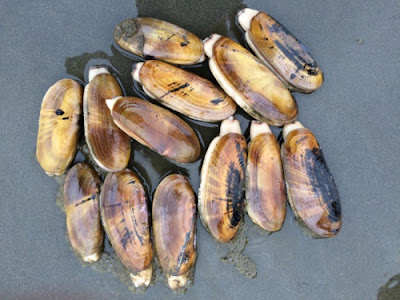Razor Clams Teach Digging Methods
Suzie's sister Sarah was selling seashells by the seashore (Suzie lives in Australia), and I saw some odd clams. Well, they were new to me. I asked what kind they were. "Those are razor clam shells", Sarah said shyly. I saw where they get their name, and when they are sticking up out of the sand, stepping on them could be an unpleasant experience.
People dig clams (see what I did there?) because they're good eatin'. Just have to watch for algal blooms that affect shellfish so you don't get poisoning from okadaic acid or domoic acid. Don't be ignoring the warning signs, old son.
 |
| Credit: NOAA / Northwest Fisheries Science Center (usage does not imply endorsement of site contents) |
Standing firmly upright in the shallows, the sharp shell of the appropriately-named razor clam can be a menace to unwary people wading barefoot or swimming at low tide. But the razor clam has attracted the interest of engineers wondering how it manages to dig itself into the seabed so effectively.No, I'm not keeping the rest of this article to myself, I'm not that shellfish. To finish reading, click on "Razor clam — Impossibly good at digging".
The thing is, engineers thought that it shouldn’t be able to do this. The insertion forces needed to embed jetty pylons and anchoring devices into the sand or mud of the sea floor are huge and costly, because the deeper you go, the harder it gets to penetrate any further.